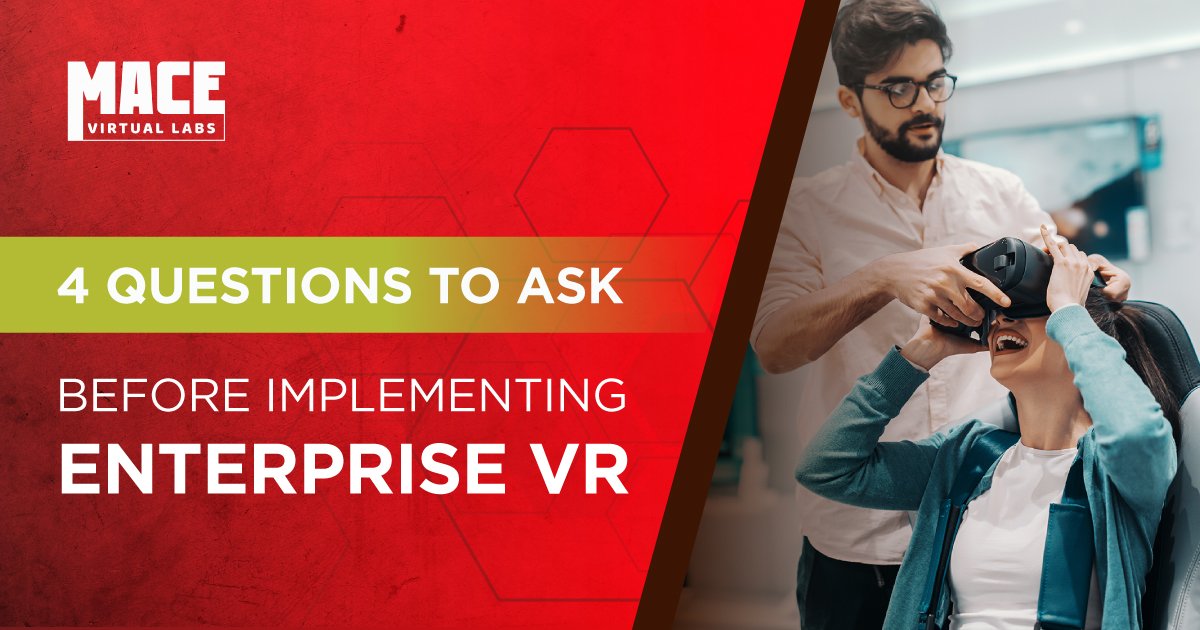4 Questions to Ask Before Implementing Enterprise VR
It’s no secret that virtual reality can positively impact just about any business. From crafting accurate prototypes to creating immersive marketing experiences, VR allows for cost-effective ways to launch and showcase new products. However, VR solutions can be tricky to implement. An emerging technology, it requires careful planning and skillful management.
Before you implement an enterprise-level VR experience, you’ll want to ask yourself the following questions to make sure you’re not wasting your time.
1. What Do We Want to Achieve?
Like any new venture, it’s important to know what your goals are so that you can properly manage their effectiveness. During this stage, you’ll want to ask yourself what exactly you hope to accomplish through VR and how you will measure its success.
For example, do you hope to use VR as part of your training process? If so, you’ll want to think about what experiences you want to simulate and how you’ll determine if VR has aided in skill acquisition. Alternatively, if you want to create an immersive experience to showcase a new product, you’ll want to think about which features you want to show off and how you’ll measure customer acquisition.
Like any tool, VR can only work successfully when implemented with care. This is why you need to take the time to figure out your greater goals and how VR could dovetail with them. Consider hiring a dedicated project manager who can oversee all aspects of VR planning, testing, and implementation.
2. Where Will It Be Located?
In addition to the people who oversee your project, you’ll also want to consider the location of your VR facility. In most cases, you’ll want to have a dedicated space for users to safely participate in training. Since VR often requires a degree of movement, you’ll want to make sure that your space is both large enough to support this and that it’s free from obstacles.
Again, this is where you’ll want to consider the exact type of VR experience you hope to create. More active experiences will generally require more space, as opposed to immersive trainings that can be done while seated.
3. Who is Responsible for Fleet Management?
A VR lab of any size will consist of ample equipment, including headsets, treadmills, gloves, trackers, and even full bodysuits. All of this advanced technology comes with issues of logistics, sanitation, storage, and software. In the way that your IT department oversees the maintenance of your company’s computer network systems, you’ll need a team to do the same for your VR setup. This is what’s known as fleet management.
It’s important to determine if your company can internally handle issues related to maintaining your VR infrastructure. In many cases, it’s prudent to outsource this role to companies like MACE Virtual Labs. They offer fleet management as a service (FMaaS), a solution that can handle the entirety of issues related to keeping your VR equipment up and running.
4. Do I Have the Right Team?
In many cases, having a dedicated VR project manager is necessary to implement VR at the enterprise level. This person can coordinate all aspects of testing, trials, and eventual implementation, coordinating with the rest of your team. Additionally, they can help manage the budget for these projects.
Even though successful VR labs appear seamless to the user, a high degree of technical knowledge is required to execute these solutions. Choosing the right equipment, integrating different products, and maintaining your system all require specialized knowledge that won’t come easy––even to IT professionals.
Start with the Right Partner
A surefire way to implement enterprise-level VR is to hire the right team. By partnering with experts who supply the equipment and aid in all aspects of its operation, you can ensure your VR goes off without a hitch.
An organization like MACE Virtual Labs functions as a one-stop-shop for enterprise VR. Whether you want to use VR for soft-skills training or research purposes, MACE can help you execute your vision. Through careful consultation, they’ll help you figure out the right equipment for your needs and how to install it, maintain it, and train your employees in its use. They even offer ongoing support to ensure your VR solution stays in working order.

